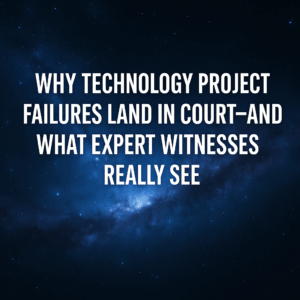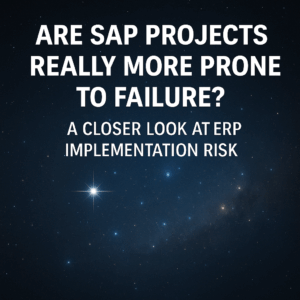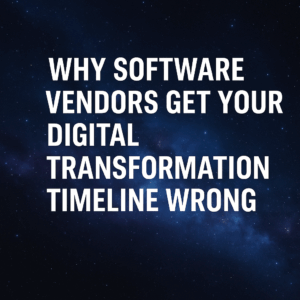Throughout the history of digital transformation and ERP projects, there’s been a lot of failures. But today, we’re going to talk about the top 10 biggest ERP failures of all time. More importantly, at the end of this blog, I will give you some tips on avoiding this type of failure. This top 10 list was hard to compile because there’s a lot to choose from.
There’s a lot of significant losses in the marketplace. I selected these top 10 based on the severity of the failure and, more importantly, the ones that we feel could be avoided.
Now, we at Third Stage, myself in particular, often act as expert witnesses in lawsuits. Many of these failed projects involve lawsuits. We were actually involved with some of the cases as expert witnesses, and some of them we weren’t. But in either case, we’re sharing publicly available information, and we’re not sharing any confidential information that we may have gathered from the lawsuits as expert witnesses.
Table of Contents
ToggleHere are the top 10 digital transformation failures.
10. Haribo
Coming in at number 10 is Haribo. They’re the company that makes gummy bears. They may be number 10 on our list, but it’s actually number one on my kids list (and maybe yours too) because kids love gummy bears! I am guessing they weren’t happy to learn that gummy bears were largely unavailable for a period of time in 2018, after their SAP implementation.
The general gist and summary of what happened here are that the company spent hundreds of millions of dollars trying to implement SAP in 2018, they finally – well, sort of implemented SAP. Haribo immediately ran into supply chain problems such as, they couldn’t track where their inventory was, they couldn’t track raw materials, and they couldn’t get the inventory to stores in time. As a result, their sales dropped roughly 25% shortly after the transformation. All of these problems are enough to land Haribo at number 10 on our list.

9. Washington Community College
Coming in, at number nine is Washington Community College. This organization tried to implement PeopleSoft in 2012. They hired Cyber to help implement the product. The tricky and unfortunate part of this project is that Cyber is filed for bankruptcy and went out of business at the time of the implementation. The college was left holding the bag, which wasn’t pretty.
Once Cyber went out of business, they were acquired by a company called the HDC, which resumed the project, but they eventually canceled the project. Keep in mind, this is HDC the vendor canceled the project, not the college. They then sued the college for $13 million saying that the reason that the project failed is because they had internal dysfunctions that couldn’t be overcome.
This is a very rare situation where the failure was probably the result of both parties. In this case, the system integrator was actually the one to sue the college. Overall, in either case, the college spent a lot of time and money and now is dealing with a lawsuit and an implementation that’s delivering little business value to the college and to its students.
8. Hewlett Packard
Coming in at number eight is Hewlett Packard the technology and hardware company. Now, Hewlett Packard spent $160 million on its ERP project. The damages to the company that they claim were caused as a result of the failed implementation were nearly five times that amount because they spent $160 million expected to get a certain ROI.
In this case, they actually lost five times that amount, which isn’t the type of ROI that most of us are looking for when we go to implement new technology. One of the interesting quotes from the CIO of HP at that time said “we had a series of small problems, none of which, individually would have been too much to handle.” Together, they created the perfect storm and that pretty well sums up what happens with a lot of these failures. This certainly was enough to land Hewlett Packard on our list of top ERP failures of all time.
7. Waste Management
Coming in at number seven is Waste Management, another company that tried to implement SAP to no avail. Waste Management spent around $100 million, according to public records on their SAP implementation, and it ultimately failed. SAP had promised that waste management would get annual benefits somewhere in the neighborhood of $100 to $200 million per year. However, those business benefits never materialized and resulted in a failure on the part of Waste Management.
One of the key challenges that Waste Management alleges that they had with this project was that SAP misrepresented the software that was being offered to them. They said that they were shown fake software during the software demonstrations. Thus, the demos weren’t the real software that SAP really had available according to public records and quotes from people from Waste Management. Their main argument in the ERP lawsuit was that SAP failed to demonstrate the product they contractually agreed to purchase.
6. Hershey’s
Coming in at number six in our list is Hershey’s, Hershey’s tried to implement SAP, they spent quite a bit of money on their implementation. What they found at the time of their go live is that they were incapable of processing roughly $100 million of orders for Hershey’s Kisses and Jolly Ranchers. And again, this is another one that may only be number six on our list, but it’s definitely in my kid’s top three because they love candy.
Some of the problems that Hershey’s ran into is that they tried to implement the product the SAP product in an unreasonably short period of time. In fact, just from the outside looking in, it looks and sounds like it was never going to happen. Those unrealistic expectations caused the first domino to fall, which led to a lot of other problems later on throughout the implementation.
Finally, one of the biggest mistakes if not THE biggest mistakes that Hershey made along with their implementation partners, is that they decided to go live during a busy holiday season when chocolate is most readily bought by customers.
This was a case where the implementation planning wasn’t very well thought out, or if it was, the risks were not well mitigated. This is just a good reminder that we need to think long and hard about when we go live, how it affects our day-to-day business, as a way to ensure that we don’t run into operational disruptions.

5. Miller Coors
Coming in at number five on our list is Miller Coors, the beer company and they also struggled with their ERP implementation. They started their SAP implementation in 2013 and spent roughly $100 million on the project. As a result of the implementation, they’re suing their system integrator, which was HCL, in this case, the Indian-based firm, which they’re suing for $100 million in damages trying to recover the losses resulting from this SAP implementation.
To add insult to injury, HCL’s public response to the lawsuit was a bit flippant. Their reaction was, it’s just one client, we have several other reference clients available for every one client that has something bad to say about us.
Disclaimer: I wasn’t involved in this project. I don’t know the inside details, but it sounds a bit like there’s some finger-pointing going on there. Either way, it’s something that could have been avoided. We will talk more at the end of this blog regarding how to avoid some of those failures. But that’s enough to land Miller Coors within our top 10.
4. Revlon
Coming in at number four is Revlon, the consumer product company, that had an SAP project recently. The interesting thing about this project is they announced it in a financial filing. That’s how the news of the failure broke to the markets and they did not respond well. Their stock dropped about 6.9% the day after that filing announced that their SAP project had failed.
Now, just a little background here, if you go read the financial and SEC filing, they actually outline in a fair amount of detail what happened with this SAP implementation. It’s really interesting to review because they’re basically explaining what happened and why it had the effect it did on the business.
To paraphrase some of what they said in that filing is that they first went live with one of their manufacturing plants in North Carolina. The minute they went live, they weren’t able to ship product, they lost customer orders, and they lost visibility to their supply chain. This essentially brought that plant to its knees and it wasn’t able to manufacture or distribute or sell products anymore, at least in the short term after the go live.
Because of some of those challenges, they had to expedite shipments. As they were tracking orders, and as customers were complaining about late orders, they were spending a lot of money expediting shipments for their customers.
Another noteworthy aspect and contributing factor to this failure is that at the time, they were implementing SAP, they had just recently acquired the company, Elizabeth Arden. They were trying to figure out how they were going to integrate that company into the core Revlon operations at the same time, they’re trying to implement SAP. Mergers and acquisitions can be one of the most complex ERP undertakings.

Here they are trying to implement a new technology at the same time they’re just trying to figure out how to fit together all of their operations. All of this created somewhat of a moving target. When we talk about ERP successes or failures, one of the big indicators is ROI.
What kind of return on investment did we get for the time and cost and money that we put into the implementation?
In the case of Revlon, it wasn’t so great. There’s a negative ROI in the form of lost sales, lost customer value, and lost customer service. This was an intangible number that they didn’t quantify, but they said that there was a material effect on the executives’ time. Not to mention the resources required to recover and deal with all the problems that resulted from that implementation. I don’t know how you quantify that but that sounds like it’s pretty significant.
There’s also an increase in capital costs, an increase in operating expenditures, and they couldn’t pay their vendors. Revlon couldn’t file the regulatory requirements and reports to the state and federal regulators. They had to expedite shipments and they lost sales. In the end, there was clearly a variety of problems with this implementation, and certainly, enough to land it among the top-up failures of all time.
3. Nike
Number three on our list is Nike, the well-known consumer product company, spent $400 million to upgrade their ERP systems recently. Spoiler, it didn’t go so well. Some of the business damages that resulted from the implementation were that the company had to take a loss of around $100 million.
The stock price dropped by around 20%, according to one outlet that we reviewed in preparing for this, and the company had to invest another five years and another $400 million to get the project on track and successful. From what we understand, again, outside looking in, and what we see in the public forums, is it sounds like the project is back on track, and they’re getting value out of their ERP system.
Now the big question here is, did they need to spend that much money? Was it worth the heartache? Could they have done it better? Could they have optimized their process through this transformation? These end results are enough to land Nike at number three.
2. National Grid
Coming in at number two is National Grid, the large utility company in the US. National Grid invested over a billion dollars on its SAP implementation. Yes, you heard me, I said a billion… not a million or any other number, but $1 billion-plus on their SAP implementation and it failed.
The reason we can say with certainty that it failed is because of the results that they publicly announced, and it was widely reported in the media. Some of these metrics, for example, is that National Grid had to spend $100 million in services to support the implementation after the fact. After they went live, they spent another $100 million dollars just supporting and stabilizing the system as it was rolled out.
They also had two system integrators, one of which was Wipro, involved, and actually, they filed a lawsuit against Wipro. If you go look on my YouTube channel, you can find a whole video that talks just about the National Grid versus Wipro lawsuit.
They also ended up bringing in Ernst Young a second and expensive system integrator to help support the implementation because it wasn’t going well with Wipro.
By the end of the project, the company was spending about $30 million a month just to support the project, while trying to get the product up and running and to get through the implementation. For any company, no matter the size is a ridiculous amount of money to be spending on trying to implement new technology.
Their whole process for the period end used to take four days before they rolled out the new ERP system. It took 43 days after they went live. In the end, definitely a negative ROI there after spending all that money.
Then finally (as if we needed more) their post go live accounts payable processes resulted in about 15,000 unpaid supplier invoices that they just couldn’t process – thus, they couldn’t pay. They had a lot of suppliers and vendors that weren’t very happy with them.
All of these end results are enough to land National Grid amongst the top of our top ten failures.
1. United States Navy
Coming in at number one on our list is the United States Navy. This US military branch that spent over a billion dollars on their ERP implementation since 1998. In fact, I think this project is still going on from what I understand. Since the most recent project data was available, they had already spent over a billion dollars on their ERP project.
They had three big system integrators helping them: IBM, Lloyd, and the EDS, according to the GAO report, which is a regulatory company that looks at accountability and oversight for the government. They put out a report saying that there were still no material improvements to the organization as a result of this billion-dollar project.
The other interesting thing is that they had reduced the scope of the project to not include the entire supply chain and financials but just to focus on the financial component of their business. In other words, they cut from their scope the whole shipyard inventory management piece of it. Despite cutting this scope significantly, they still spent over a billion dollars and still had trouble with the project, which also affected 90,000 employees. These 90,000 employees were stuck trying to deal with this new system that apparently didn’t deliver a lot of value to the organization.

This is the reason why the US Navy ERP implementation comes in at number one on our list.
So, what gives… why did these projects fail? And more importantly, what can we do to avoid this type of disaster? Or more likely, how can we avoid a more moderate failure that we’re not going to read about in the news, but still becomes painful for our organization? How can we navigate those pitfalls? And what is it we can do to avoid this type of failure?
Tips on Avoiding ERP Failures
- Choose the best software for your organization. Make sure you’ve got the right technology supporting your business and that you’re not choosing software / implementing software in a biased way.
- Choose the right system integrator. It’s pivotal to ensure that you have the right partner(s) helping you implement. Just because it’s a big or a well-known system integrator doesn’t mean that you’re immune to failure, or that you won’t get fired and that your project won’t fail.
If you look at the top 10 list here from above, you’ll notice that there’s a lot of notable and well-respected system integrators that were involved in those failures. In some cases, they’re involved in litigation as a result.
Key Takeaways for Your ERP Implementation
A key takeaway to remember is that you are in charge of your project. This is yours. It’s not the software vendors, it’s not your system integrators and you need to take ownership to ensure your project successful. If your system integrator isn’t working out, it’s time to make a correction.
Ultimately, you should have clear direction on what you expect for them, or fire them if you need to bring in additional help. Also, make sure that you’re the one mitigating risks and identify risks. System integrators generally aren’t very good at mitigating risks and identifying where the risks are, because they’re the fox guarding the henhouse, so to speak. With all of this said, it is essential to have independent risk mitigation as part of this whole concept of making sure that you’re in charge, and you do what you need to do to make the project successful.
The other thing to remember is that operational disruption is your biggest risk and potentially your biggest cost for the implementation. Companies will cut corners, and step over dollars to pick up pennies. They will under-invest in things like organizational change management, try to unreasonably compress the timeline, and cut the budget. Businesses do this all in the name of saving money and thinking that they’re increasing ROI.
The problem here is that these companies are not considering what’s going to happen on the other side when they go live, and this materially affects their business. Generally, the companies that have operational disruptions find that that money lost after go live is a lot more damaging than the money they could have invested to get it right in the first place on the early implementation.

A second takeaway to focus on is Business Process Management. Some key tips here are:
- Defining what you want your business processes and your operations to look like.
- Defining your business blueprint and let that drive your transformation.
Don’t fall into the trap of deferring to the technology and assuming it will allow you or help you figure out how to run your business. You need to determine how your business processes need to look. These aligned strategies will then help you define how your technology can best support your business.
Along these same lines, we should also be focused on user acceptance testing. Make sure that we thoroughly test the product and business processes. It’s very important to stress test the overall solution and the end-to-end business processes. Each of these failures shouldn’t have happened. In fact, they wouldn’t have happened if they had a stringent and effective user acceptance testing process that would have identified these problems before they go live.
It gets back to the concept of you owning this or you managing this project as a business. User acceptance testing is no exception. Had the companies above been effective in their user acceptance testing, the many not have lost millions (in some cases billions) of dollars. This is something that we recommend that you have an independent third party, someone outside the system integrator, help navigate and help facilitate in your process.
Executive Leadership Involvement
The next thing is executive alignment. Make sure that your executives are involved. They should roll up their sleeves and help make some of the decisions that need to be made as part of the digital transformation. They should also be well informed of what’s happening in the project and aware of the risks.
This is a big problem that we see with executives is they don’t necessarily know what the risks are, partly because they’re not being as involved as they should be. But also, partly because the project team either doesn’t know or isn’t sharing what some of the real risks and the impact they could have on the bottom line.
Closing
Make sure you have independent technology-agnostic support to help you through the digital transformation. That’s one of the best things you can do to ensure that you keep your project on track.
My team and I at Third Stage have provided this type of support for many of our clients over the years. Hopefully, these tips can help avoid your future ERP failures. If you’d like more customized feedback on your ERP strategy and best practices for your specific organization, feel free to contact me directly. I am happy to be an informal sounding board for your project and throughout your business transformation journey.






